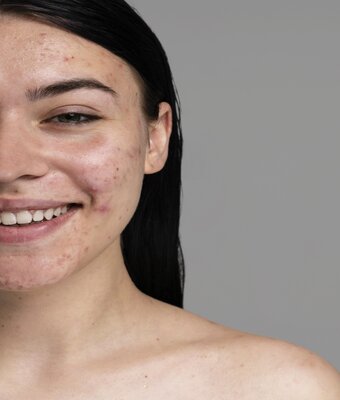
Does Benzoyl Peroxide Help Acne Scars? A Deep Dive into This Acne Treatment
Acne is a widespread skin condition that impacts millions of people worldwide, no matter their age or skin type. While there are numerous treatment options available, benzoyl peroxide remains a top choice for its proven ability to tackle acne breakouts. But you might be wondering, does benzoyl peroxide help acne scars? In this post, we’ll dive into how benzoyl peroxide works, its benefits, potential side effects, and how you can effectively include it in your skincare routine for clearer, healthier skin.
What is Benzoyl Peroxide?
Benzoyl peroxide is a topical medication widely used to treat acne. It works by killing the bacteria (Propionibacterium acnes) responsible for acne breakouts, reducing inflammation, and helping to unclog pores. Available in over-the-counter formulations as well as prescription-strength products, benzoyl peroxide comes in various concentrations, typically ranging from 2.5% to 10%.
How Does Benzoyl Peroxide Work?
Benzoyl peroxide is a powerful antibacterial agent that targets the bacteria that thrive in the blocked hair follicles and contribute to acne development. Here’s how it works:
- Eliminating Acne-Causing Bacteria: Benzoyl peroxide penetrates the skin and kills bacteria that cause acne. It works as an oxidizing agent, which means it introduces oxygen into the pores, creating an environment where these bacteria can’t survive.
- Unclogging Pores: By removing dead skin cells and excess oil, benzoyl peroxide helps clear blocked pores, reducing the likelihood of new breakouts.
- Reducing Inflammation: Benzoyl peroxide reduces the redness and swelling associated with acne, helping to heal active blemishes faster.
Benefits of Using Benzoyl Peroxide for Acne
Benzoyl peroxide offers several advantages for those dealing with mild to moderate acne:
- Fast Results: Visible improvements can often be seen within a few days to a few weeks of consistent use.
- Preventative Action: It not only treats existing pimples but also prevents new ones from forming.
- Affordable and Accessible: Benzoyl peroxide is readily available in drugstores and online at relatively low costs, making it a popular choice for many.
- Can Be Combined with Other Treatments: For stubborn acne, benzoyl peroxide can be used alongside other topical treatments like retinoids or salicylic acid.
Side Effects and How to Manage Them
While benzoyl peroxide is effective, it’s not without side effects. Some users may experience:
- Dryness and Peeling: As benzoyl peroxide exfoliates the skin, it can cause dryness or peeling, especially in sensitive areas.
- Redness and Irritation: At higher concentrations, some people may experience redness, itching, or a burning sensation.
- Bleaching of Fabrics: Benzoyl peroxide can bleach towels, clothing, and bed linens. Always use white fabrics when using products containing benzoyl peroxide.
To minimize side effects, start with a lower concentration (2.5%) and gradually increase as your skin adjusts. Moisturizing regularly and using a gentle cleanser can also help reduce irritation.
How to Use Benzoyl Peroxide for Acne
Incorporating benzoyl peroxide into your skincare routine is simple. Here are a few tips to get the most out of this treatment:
- Start Slowly: If you’re new to benzoyl peroxide, begin by applying a small amount once a day. As your skin gets used to the product, you can increase the frequency to twice a day.
- Apply to Clean Skin: Make sure your face is clean and dry before applying benzoyl peroxide. Use a mild cleanser to avoid over-drying the skin.
- Use Sunscreen: Benzoyl peroxide can make your skin more sensitive to the sun, so it’s important to use sunscreen daily to protect your skin from UV damage.
- Combine with Other Acne Treatments: If you’re already using other topical acne treatments, consider consulting with a dermatologist to ensure they’re safe to use together.
When to See a Dermatologist
While benzoyl peroxide can effectively treat mild to moderate acne, it may not be sufficient for everyone. If your acne persists or worsens, it’s essential to consult with a professional. Dermatologists in London, for example, can assess your skin condition and recommend personalized treatments that go beyond over-the-counter options.
Conclusion
Benzoyl peroxide is a trusted and effective solution for managing acne. With its ability to kill acne-causing bacteria, reduce inflammation, and unclog pores, it’s a popular choice for those looking to clear their skin. However, like any skincare product, it’s important to use it correctly to avoid side effects. If you’re unsure about how to use benzoyl peroxide or need further guidance, a dermatologist can help tailor your treatment plan to meet your skin’s specific needs.
By incorporating benzoyl peroxide into your acne-fighting routine and making adjustments based on your skin’s response, you can achieve clearer, healthier skin.
FAQ
Can benzoyl peroxide be used on sensitive skin?
Yes, but if you have sensitive skin, it’s best to start with a lower concentration (like 2.5%) and apply it once a day. Always follow up with a moisturizer to reduce dryness and irritation.
How long does it take for benzoyl peroxide to show results?
Results can vary depending on your skin type and the severity of your acne. However, most people see improvements within 4 to 6 weeks of consistent use.
Can I use benzoyl peroxide with other acne treatments?
Yes, benzoyl peroxide can be used alongside other treatments like salicylic acid or retinoids, but it’s important to consult a dermatologist before combining products to avoid irritation.
Is benzoyl peroxide safe for long-term use?
Benzoyl peroxide is generally safe for long-term use, but it can cause skin dryness or irritation over time. It’s important to monitor your skin’s reaction and consult a dermatologist if needed.
Can benzoyl peroxide make my acne worse at first?
Some users may experience an initial “purging” phase where acne seems to get worse before it improves. This is normal and usually temporary, as your skin adjusts to the treatment.


